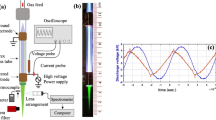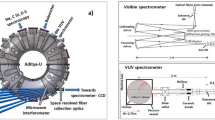Abstract
THE intensity of strong neutral argon emission lines radiated, by the thermally excited argon shield gas surrounding and within the central d.c. arc plasma of the Heliweld thoriated tungsten electrode welding arc has been measured. This arc was operated at 15 V and 135 amp (d.c.), providing a good source for thermally exciting neutral argon emission lines at a voltage below the ionization voltage (argon = 15.8 V).
This is a preview of subscription content, access via your institution
Access options
Subscribe to this journal
Receive 51 print issues and online access
$199.00 per year
only $3.90 per issue
Buy this article
- Purchase on Springer Link
- Instant access to full article PDF
Prices may be subject to local taxes which are calculated during checkout
Similar content being viewed by others
References
Meggers, W. F., J. Opt. Soc. Amer., 31, 610 (1941).
Author information
Authors and Affiliations
Rights and permissions
About this article
Cite this article
MITCHELL, C. Intensity of Neutral Argon Emission Lines radiated by the Low-voltage–High-amperage Arc compared with Four High-voltage Type Arcs. Nature 200, 1194–1195 (1963). https://doi.org/10.1038/2001194c0
Issue Date:
DOI: https://doi.org/10.1038/2001194c0
Comments
By submitting a comment you agree to abide by our Terms and Community Guidelines. If you find something abusive or that does not comply with our terms or guidelines please flag it as inappropriate.



